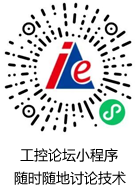问答系列(二十七) 点击:2127 | 回复:0
发表于:2002-10-28 14:10:00
楼主
We are currently developing a Class2-only, bus powered, valve controller. In the DeviceNet spec is specified that the device must work down to 11Volt. It is possible for us to let all DeviceNet communication and micro-controller work down to this l1 volt. However, the valve that is controlled by the electronic cannot operate at 11 volt, and the system will then send an alarm as with other malfunctions. My question is: to have the product certified it has to run at 11V, but is it only all the "DeviceNet system" that have to run at 11V? Does the certification cover only the DeviceNet part or also the device we are controlling?
Answered by Matt Kuzel, Chairman of the Physical Layer SIG,
e-mail: kuzel@voyager.net .
A277) My understanding of the conformance tests is that although Devices are tested over the full power supply range, I/O behavior is not checked. So, you can have a device pass the test, become certified, and still not operate at 11V. After a few e-mail exchanges with members of the conformance SIG I have an update to my earlier reply. Even though there are no tests that presently check I/O very well, if a device is known to be non-compliant, it will not be certified. The behavior that you describe is certainly considered to be non-compliant, and therefore the device would not be certified.
I have a problem with a DeviceNet system connected to a robot welding system. We are continually getting I/O errors and communication errors. The only way to re-connect is to shut down and re-boot...sometimes several times. The cable is in metal clad seal-tight, which runs from the robot computer scanner to the modules. The drain wire is grounded only at one end. I would like some suggestions on how to end this problem. I am thinking of a new connector, and using ferrites on both ends of the cable.
Answered by Nick Jones
e-mail: njones@mySST.com ,
or Joe Hruska
e-mail: hruskjm@ch.etn.com .
A286) There are many different communication and I/O errors. Is a node transitioning to the Bus Off state (Network Status LED is solid red)? Bus Off is the result of a DeviceNet node detecting many Error Frames over a short period of time. An Error Frame is generated when a message is corrupted by severe noise, insufficient amplitude, or improper format. A common cause of Bus Off is improper or loose wiring. A missing or incorrectly placed bus terminator may cause Bus Off. Check for loose wires at all DeviceNet connectors. Motion and vibration can cause loose wires to "make and break" contact. DeviceNet V- and SHIELD should be connected together at exactly one point. A heavy (8 AWG or larger) copper wire should connect the junction of V- and SHIELD with a solid earth ground (cold water pipe, 8-foot copper rod in damp earth). The 8 AWG wire to earth ground should be short (less than 10 feet long) and must NOT be used to ground other equipment. A machine or electrical cabinet chassis is NOT an acceptable earth ground for DeviceNet. See ODVA DeviceNet specifications Volume I, Section 9-3.9. Make sure that SHIELD is not connected to the chassis of any equipment. DeviceNet 24 VDC power should not be used to power other equipment. You should be using DeviceNet nodes that provide electrical isolation between the DeviceNet network and process equipment. Some DeviceNet products do not provide isolation between external wiring and the DeviceNet network. Do not use ferrites on DeviceNet cable. The combination of differential signaling, twisted pair cable, and grounded SHIELD allow DeviceNet to operate in very noisy environments. The problem is most likely a loose wire at a connector or a poorly grounded network. Please describe the errors and network configuration in detail if the problem is not resolved by inspection of wiring and grounding.
热门招聘
相关主题
- 用CAN发送多帧数据,帧间间隔...
 [1573]
[1573] - Wi-Fi铸造无线神奇
 [1749]
[1749] - 转载:PROFIBUS与现场总线国际...
 [2367]
[2367] - RS485与现场总线的区别
 [1673]
[1673] - PLC的LIN总线通讯解决方案
 [1979]
[1979] - RS232-485转换器怎么做?
 [2793]
[2793] - 从事现场总线研究前景如何?
 [1702]
[1702] - PLC上有一个指示灯"DIA"是出...
 [2717]
[2717] - 基于摩托罗拉Coldfire处理器...
 [1670]
[1670] - 串口转TCP/IP模块的上位机TC...
 [1657]
[1657]

官方公众号

智造工程师
-

 客服
客服

-

 小程序
小程序

-

 公众号
公众号

















 工控网智造工程师好文精选
工控网智造工程师好文精选
